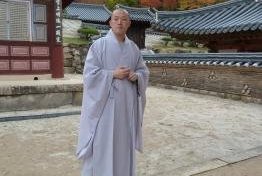
Once or twice every year I try and put a little bit of extra effort into visiting a certain World Heritage Site. This is in the hope that it will reveal a little bit more about the place and also to stop me from getting blasé about consistently visiting some of the ‘most outstanding’ places on earth. This time around the site I picked out for a bit of special treatment was Haeinsa.
I decided to partake in the Korean government's Temple stay programme. I wasn't after some kind of spiritual awakening, just a slightly more unique take on the functions of the temple. And that is precisely what the experience delivered. I stayed for one night, arriving on a very busy Saturday afternoon I was surprised to see just how many people had trekked up through the national park to arrive at the temple. It was the anniversary of the Tripitaka Koreana so the crowds were extra dense, making this by far the busiest WHS I visited in Korea. Although it detracted a little from the atmosphere the people certainly had the right idea.
Staying in the temple overnight allowed me to see the compounds with the tourists gone, leaving only my fellow apprentices to view the life of the monks. The highlight for me was the drumming sessions that took place on the main courtyard on the giant Jingo-buk? (I am not very up on my East Asian drumming techniques but it was very reminiscent of the famous Kodo style from Japan). From the impressive drumming displays we were lead into the service in the ornately decorated main prayer hall. After this we had a tasty vegetarian meal were taught the basics of meditation and got a chance to ask a monk about his daily life.
This was really interesting and added character to the whole complex. Whilst serving us copious amounts of tea our exceedingly friendly and knowledgeable teacher talked about how he trained to get to the monastery, the routines of daily life but perhaps the most interesting things were the part of their life that I would never have thought of. It was enlightening to find out that their kimchee contained no garlic or chilli's to prevent them from being aphrodisiacs. Also the monastery not only has a football pitch out the back, but that each new year of scholars has a different colour kit to wear, and perhaps most surprisingly of all, when our monk wasn't in the confines of the monastery he loved touring contemporary art galleries in Europe, admitting he has a particular love of the works of Egon Schiele (perhaps making up for a lack of garlic in his life?). This really added colour and a new level of understanding to this site visit for me.
It was an early and restless night in a communal hall sleeping on an ondol floor, before we were woken up at 3:30am to start the second day's activities. We again witnessed the drumming and service before having another meal (the same food, but this time around it felt a little less satisfying). Then it was time for the 108 bows, I must admit to not really comprehending how much effort goes into this ritual, and I was sweating heavily by the time I had reach about 50 full prostrations, I had to really dig into my reserves to make it the whole way through, realising I am a long way from my former levels of fitness, and understanding why all the monks looked so fit and healthy. After some time to meditate my recovery from the morning's excursions was completed when we were taken off on a tour by our friendly teacher. This took us up to the highest part of the compound which is actually the World Heritage Site, being the housing for the Tripitaka Koreana engraved on wooden blocks. As an actual spectacle is isn't really that impressive, however given the surrounds of the temple and the knowledge of how old and complete this collection is really does make it astounding.
If you don't fancy the idea of 3:30am starts and 108 full prostrations then you can also stay in the beautiful national park with-in walking distance of the site and wander in to see the drumming and services, as well as queuing for the chance to join the monks and their apprentices for meals. I would recommend the temple stay for anyone that wants to get a better understanding of life in the monastery. If you are looking for a spiritual experience then it may disappoint, but for me this was a perfect way of enhancing my understanding and providing a more unique site visit.
[Site 7: Experience 8]
More on
Comments
No comments yet.
